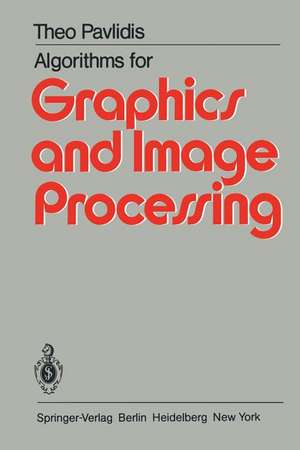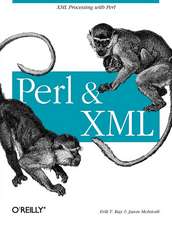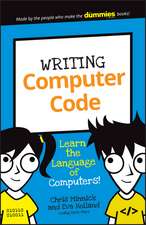Algorithms for Graphics and Image Processing
Autor T. Pavlidisen Limba Engleză Paperback – 16 ian 2012
Preț: 652.73 lei
Preț vechi: 815.91 lei
-20% Nou
Puncte Express: 979
Preț estimativ în valută:
124.91€ • 135.64$ • 104.93£
124.91€ • 135.64$ • 104.93£
Carte tipărită la comandă
Livrare economică 22 aprilie-06 mai
Preluare comenzi: 021 569.72.76
Specificații
ISBN-13: 9783642932106
ISBN-10: 364293210X
Pagini: 466
Ilustrații: XVIII, 448 p.
Dimensiuni: 152 x 229 x 24 mm
Greutate: 0.62 kg
Ediția:Softcover reprint of the original 1st ed. 1982
Editura: Springer Berlin, Heidelberg
Colecția Springer
Locul publicării:Berlin, Heidelberg, Germany
ISBN-10: 364293210X
Pagini: 466
Ilustrații: XVIII, 448 p.
Dimensiuni: 152 x 229 x 24 mm
Greutate: 0.62 kg
Ediția:Softcover reprint of the original 1st ed. 1982
Editura: Springer Berlin, Heidelberg
Colecția Springer
Locul publicării:Berlin, Heidelberg, Germany
Public țintă
ResearchCuprins
1: Introduction.- 1.1 Graphics, Image Processing, and Pattern Recognition.- 1.2 Forms of Pictorial Data.- 1.2.1 Class 1: Full Gray Scale and Color Pictures.- 1.2.2 Class 2: Bilevel or “Few Color” pictures.- 1.2.3 Class 3: Continuous Curves and Lines.- 1.2.4 Class 4: Points or Polygons.- 1.3 Pictorial Input.- 1.4 Display Devices.- 1.5 Vector Graphics.- 1.6 Raster Graphics.- 1.7 Common Primitive Graphic Instructions.- 1.8 Comparison of Vector and Raster Graphics.- 1.9 Pictorial Editor.- 1.10 Pictorial Transformations.- 1.11 Algorithm Notation.- 1.12 A Few Words on Complexity.- 1.13 Bibliographical Notes.- 1.14 Relevant Literature.- 1.15 Problems.- 2: Digitization of Gray Scale Images.- 2.1 Introduction.- 2.2 A Review of Fourier and other Transforms.- 2.3 Sampling.- 2.3.1 One-dimensional Sampling.- 2.3.2 Two-dimensional Sampling.- 2.4 Aliasing.- 2.5 Quantization.- 2.6 Bibliographical Notes.- 2.7 Relevant Literature.- 2.8 Problems.- Appendix 2.A: Fast Fourier Transform.- 3: Processing of Gray Scale Images.- 3.1 Introduction.- 3.2 Histogram and Histogram Equalization.- 3.3 Co-occurrence Matrices.- 3.4 Linear Image Filtering.- 3.5 Nonlinear Image Filtering.- 3.5.1 Directional Filters.- 3.5.2 Two-part Filters.- 3.5.3 Functional Approximation Filters.- 3.6 Bibliographical Notes.- 3.7 Relevant Literature.- 3.8 Problems.- 4: Segmentation.- 4.1 Introduction.- 4.2 Thresholding.- 4.3 Edge Detection.- 4.4 Segmentation by Region Growing.- 4.4.1 Segmentation by Average Brightness Level.- 4.4.2 Other Uniformity Criteria.- 4.5 Bibliographical Notes.- 4.6 Relevant Literature.- 4.7 Problems.- 5: Projections.- 5.1 Introduction.- 5.2 Introduction to Reconstruction Techniques.- 5.3 A Class of Reconstruction Algorithms.- 5.4 Projections for Shape Analysis.- 5.5 Bibliographical Notes.- 5.6Relevant Literature.- 5.7 Problems.- Appendix 5.A: An Elementary Reconstruction Program.- 6: Data Structures.- 6.1 Introduction.- 6.2 Graph Traversal Algorithms.- 6.3 Paging.- 6.4 Pyramids or Quad Trees.- 6.4.1 Creating a Quad Tree.- 6.4.2 Reconstructing an Image from a Quad Tree.- 6.4.3 Image Compaction with a Quad Tree.- 6.5 Binary Image Trees.- 6.6 Split-and-Merge Algorithms.- 6.7 Line Encodings and the Line Adjacency Graph.- 6.8 Region Encodings and the Region Adjacency Graph.- 6.9 Iconic Representations.- 6.10 Data Structures for Displays.- 6.11 Bibliographical Notes.- 6.12 Relevant Literature.- 6.13 Problems.- Appendix 6.A: Introduction to Graphs.- 7: Bilevel Pictures.- 7.1 Introduction.- 7.2 Sampling and Topology.- 7.3 Elements of Discrete Geometry.- 7.4 A Sampling Theorem for Class 2 Pictures.- 7.5 Contour Tracing.- 7.5.1 Tracing of a Single Contour.- 7.5.2 Traversal of All the Contours of a Region.- 7.6 Curves and Lines on a Discrete Grid.- 7.6.1 When a Set of Pixels is not a Curve.- 7.6.2 When a Set of Pixels is a Curve.- 7.7 Multiple Pixels.- 7.8 An Introduction to Shape Analysis.- 7.9 Bibliographical Notes.- 7.10 Relevant Literature.- 7.11 Problems.- 8: Contour Filling.- 8.1 Introduction.- 8.2 Edge Filling.- 8.3 Contour Filling by Parity Check.- 8.3.1 Proof of Correctness of Algorithm 8.3.- 8.3.2 Implementation of a Parity Check Algorithm.- 8.4 Contour Filling by Connectivity.- 8.4.1 Recursive Connectivity Filling.- 8.4.2 Nonrecursive Connectivity Filling.- 8.4.3 Procedures used for Connectivity Filling.- 8.4.4 Description of the Main Algorithm.- 8.5 Comparisons and Combinations.- 8.6 Bibliographical Notes.- 8.7 Relevant Literature.- 8.8 Problems.- 9: Thinning Algorithms.- 9.1 Introduction.- 9.2 Classical Thinning Algorithms.- 9.3 Asynchronous Thinning Algorithms.- 9.4 Implementation of an Asynchronous Thinning Algorithm.- 9.5 A Quick Thinning Algorithm.- 9.6 Structural Shape Analysis.- 9.7 Transformation of Bilevel Images into Line Drawings.- 9.8 Bibliographical Notes.- 9.9 Relevant Literature.- 9.10 Problems.- 10: Curve Fitting and Curve Displaying.- 10.1 Introduction.- 10.2 Polynomial Interpolation.- 10.3 Bezier Polynomials.- 10.4 Computation of Bezier Polynomials.- 10.5 Some Properties of Bezier Polynomials.- 10.6 Circular Arcs.- 10.7 Display of Lines and Curves.- 10.7.1 Display of Curves through Differential Equations.- 10.7.2 Effect of Round-off Errors in Displays.- 10.8 A Point Editor.- 10.8.1 A Data Structure for a Point Editor.- 10.8.2 Input and Output for a Point Editor.- 10.9 Bibliographical Notes.- 10.10 Relevant Literature.- 10.11 Problems.- 11: Curve Fitting with Splines.- 11.1 Introduction.- 11.2 Fundamental Definitions.- 11.3 B-Splines.- 11.4 Computation with B-Splines.- 11.5 Interpolating B-Splines.- 11.6 B-Splines in Graphics.- 11.7 Shape Description and B-splines.- 11.8 Bibliographical Notes.- 11.9 Relevant Literature.- 11.10 Problems.- 12: Approximation of Curves.- 12.1 Introduction.- 12.2 Integral Square Error Approximation.- 12.3 Approximation Using B-Splines.- 12.4 Approximation by Splines with Variable Breakpoints.- 12.5 Polygonal Approximations.- 12.5.1 A Suboptimal Line Fitting Algorithm.- 12.5.2 A Simple Polygon Fitting Algorithm.- 12.5.3 Properties of Algorithm 12.2.- 12.6 Applications of Curve Approximation in Graphics.- 12.6.1 Handling of Groups of Points by a Point Editor.- 12.6.2 Finding Some Simple Approximating Curves.- 12.7 Bibliographical Notes.- 12.8 Relevant Literature.- 12.9 Problems.- 13: Surface Fitting and Surface Displaying.- 13.1 Introduction.- 13.2 Some Simple Properties of Surfaces.- 13.3 Singular Points of a Surface.- 13.4 Linear and Bilinear Interpolating Surface Patches.- 13.5 Lofted Surfaces.- 13.6 Coons Surfaces.- 13.7 Guided Surfaces.- 13.7.1 Bezier Surfaces.- 13.7.2 B-Spline Surfaces.- 13.8 The Choice of a Surface Partition.- 13.9 Display of Surfaces and Shading.- 13.10 Bibliographical Notes.- 13.11 Relevant Literature.- 13.12 Problems.- 14: The Mathematics of Two-Dimensional Graphics.- 14.1 Introduction.- 14.2 Two-Dimensional Transformations.- 14.3 Homogeneous Coordinates.- 14.3.1 Equation of a Line Defined by Two Points.- 14.3.2 Coordinates of a Point Defined as the Intersection of Two Lines.- 14.3.3 Duality.- 14.4 Line Segment Problems.- 14.4.1 Position of a Point with respect to a Line.- 14.4.2 Intersection of Line Segments.- 14.4.3 Position of a Point with respect to a Polygon.- 14.4.4 Segment Shadow.- 14.5 Bibliographical Notes.- 14.6 Relevant Literature.- 14.7 Problems.- 15: Polygon Clipping.- 15.1 Introduction.- 15.2 Clipping a Line Segment by a Convex Polygon.- 15.3 Clipping a Line Segment by a Regular Rectangle.- 15.4 Clipping an Arbitrary Polygon by a Line.- 15.5 Intersection of Two Polygons.- 15.6 Efficient Polygon Intersection.- 15.7 Bibliographical Notes.- 15.8 Relevant Literature.- 15.9 Problems.- 16: The Mathematics of Three-Dimensional Graphics.- 16.1 Introduction.- 16.2 Homogeneous Coordinates.- 16.2.1 Position of a Point with respect to a Plane.- 16.2.2 Intersection of Triangles.- 16.3 Three-Dimensional Transformations.- 16.3.1 Mathematical Preliminaries.- 16.3.2 Rotation around an Axis through the Origin.- 16.4 Orthogonal Projections.- 16.5 Perspective Projections.- 16.6 Bibliographical Notes.- 16.7 Relevant Literature.- 16.8 Problems.- 17: Creating Three-Dimensional Graphic Displays.- 17.1 Introduction.- 17.2 TheHidden Line and Hidden Surface Problems.- 17.2.1 Surface Shadow.- 17.2.2 Approaches to the Visibility Problem.- 17.2.3 Single Convex Object Visibility.- 17.3 A Quad Tree Visibility Algorithm.- 17.4 A Raster Line Scan Visibility Algorithm.- 17.5 Coherence.- 17.6 Nonlinear Object Descriptions.- 17.7 Making a Natural Looking Display.- 17.8 Bibliographical Notes.- 17.9 Relevant Literature.- 17.10 Problems.- Author Index.- Algorithm Index.









